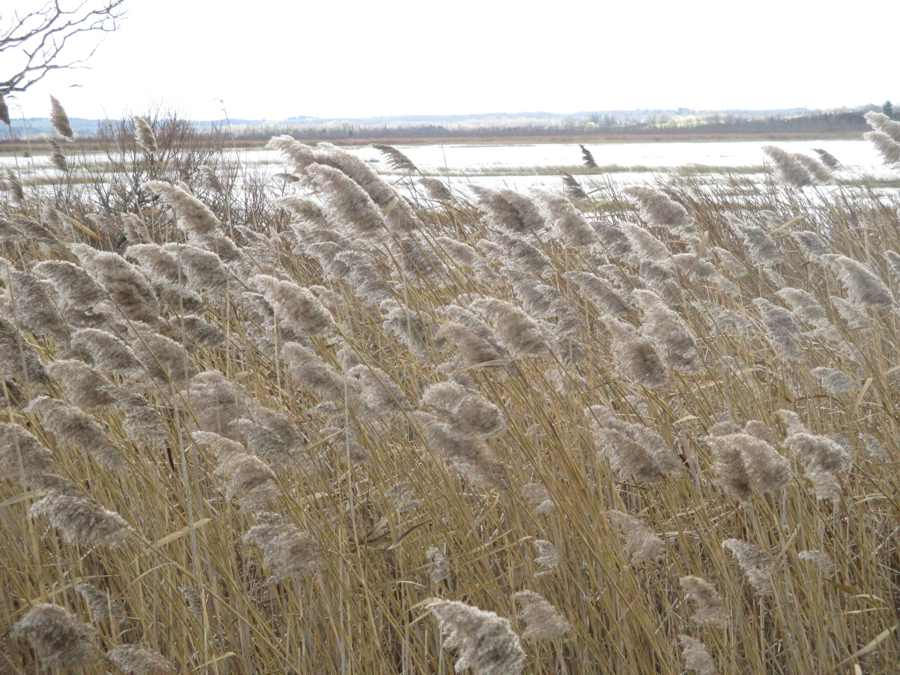Cranberry Marsh is Draining Into Lake Ontario: Coastal Wetlands and Barrier Beaches
- mbreems8
- Mar 12, 2024
- 3 min read
Updated: Apr 5, 2024

Cranberry Marsh at Lynde Shores Conservation Area. The red circle highlights the breach in the barrier beach where the marsh was draining into Lake Ontario earlier this spring. As of April the beach closed up again and the marsh is slowly filling with water.
Barrier beach dynamics
Great Lakes’ coastal wetlands form at the mouths of rivers and in bays along the shoreline. Many coastal wetlands in Durham Region are separated from Lake Ontario by barrier beach systems. Barrier beaches, naturally, are very dynamic as they are influenced by lake and wetland water levels, and by wind and wave action. Barriers can open when water levels in the wetland rise above the lake, and close when waves from the lake push the sand or cobble back across the opening. When, where, and how long these barrier beaches remain open and closed varies among wetlands and with weather conditions.

2018 photo of Cranberry Marsh at Lynde Shores Conservation Area showing intact barrier beach separating the marsh from Lake Ontario.
As the barrier beach changes, water levels in coastal wetlands can rapidly change by 50 cm or more. Coastal wetlands require these fluctuations in water levels to sustain their high levels of biodiversity. The plants and animals living in these wetlands have adapted to be able to withstand such extreme changes. For example, periods of sustained low water levels expose sediments containing seed banks, allowing emergent vegetation species to germinate and re-establish in the wetland. They also prevent the expansion of aggressive emergent plants (e.g., Cattails) into dryer meadow marsh communities. High water levels expand the aquatic zone upslope, and prevent the invasion of upland woody plants. Fluctuations between these high and low water level periods maintain high vegetation species’ diversity and a balance of shallow aquatic, shallow marsh, and meadow marsh vegetation communities. This diversity in vegetation species and communities attracts various wildlife species and provides a critical habitat for many wetland-dependent species.
Not all change is good, even for barrier beaches
Central Lake Ontario Conservation Authority (CLOCA) has been collaborating with coastal engineers to study the long-term changes affecting the barrier beaches in Durham Region. These beaches, crucial for shoreline protection, are dynamic systems that play a vital role in mitigating the impacts of climate change. However, alterations in sediment movement within Lake Ontario have rendered these beaches increasingly vulnerable.
Barrier beaches rely on a steady supply of sand transported by lake currents. Unfortunately, shoreline development (e.g., stone and concrete) and the construction of pier structures disrupt this natural process, reducing the availability of sand to coastal habitats. At locations like Cranberry Marsh and Lynde Creek Marsh, sediment supply has been reduced by armouring of nearby shoreline, while beach erosion has been active during high Lake level periods. Consequently, the barrier beaches are shrinking, heightening the risk of frequent breaches and loss of water in the wetlands. These smaller beaches are also more susceptible to extreme water levels and storm events, phenomena expected to worsen with climate change.

Photo taken last year (February 2023) by John M. showing a breach in the barrier beach at Cranberry Marsh at Lynde Shores Conservation Area.
While occasional breaches can benefit wetlands, CLOCA is concerned about the rapid rate of erosion, the diminishing sand supply, and the overall resilience of these ecosystems to climate change impacts. Addressing these challenges requires a comprehensive understanding of the complex interactions between sediment dynamics, shoreline development, and climate change effects.
What are we doing to fix it?
Central Lake Ontario Conservation Authority has been actively collaborating with numerous partners to gain a comprehensive understanding of the current conditions and impacts affecting the barrier beaches of Cranberry Marsh and Lynde Creek Marsh. Recognizing the critical importance of these barrier beaches in maintaining vibrant coastal wetland habitats, CLOCA is committed to ensuring their resilience to future climate change impacts. Over the past year, CLOCA has worked closely with Environment and Climate Change Canada to develop a strategic plan for the preservation and enhancement of these vital coastal ecosystems. Currently, we are in the process of securing funding to initiate the planning phase for the design strategies.
Given the scale and significance of this project, it is imperative that it is executed with precision and thoroughness to ensure long-term stability and protection of the barrier beaches and associated habitats. While this undertaking is a high priority for CLOCA, it will require time and careful consideration. We are dedicated to keeping the public informed about our progress as we advance through each stage of the project. Your support and engagement are crucial as we work towards safeguarding these invaluable coastal resources for generations to come.
For updates or to learn more about coastal wetlands, visit our website at https://www.cloca.com/watershed-monitoring-protection or contact:
Michael Grieve, Wetland Biologist
Central Lake Ontario Conservation Authority




Comments